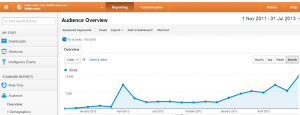Grabbing a Share of the Pie – Marketing Fiddle Salad Correctly
The idea of running Fiddle Salad came in a weird way. At first, I was just making a Python to JavaScript compiler and putting it on a website. It was simple enough, as the compiler was already built for it. The back-end for saving and authentication through Google, Twitter, and Facebook used the same one as Python Fiddle. After the site was launched, I noticed that not many people were interested in writing Python. Also, I got a taste of CoffeeScript, which is now my favorite language.
I think the demise of the Python-only fiddle came as a combination of low traffic and no saves. If nobody ever sees it or uses it, then it is better gone. Fortunately, I had the chance to design and develop the next generation of Fiddle Salad to support other languages.
The real Fiddle Salad was launched in April of 2012. I remembered calling the previous version Python Fiddle. Last January, I decided to do an experiment with the CoffeeScript page by creating a separate app in the Chrome App Store. It turned out to double my number of daily visitors. Last May, it was featured on Lifehacker as one of the best apps for development. So why not do it again?
I waited until the right time. Last month and the previous one, the project received major updates which I will be discussing on the Fiddle Salad blog. Meanwhile, I published more apps in the Chrome App Store.
The difference now is that instead of an app supporting more features that show up in searches, I’ve limited the features that are marketed. This way it targets specific audiences. JavaScript programmers don’t want to find out about the features built for CoffeeScript, and a programmer looking for a CoffeeScript IDE won’t bother with an app that doesn’t have CoffeeScript in the title.
